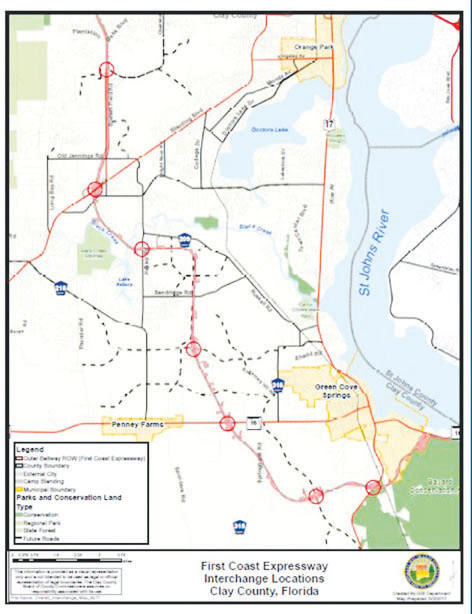Changing a community
First Coast Expressway impact becoming real
ORANGE PARK – When Edward Gaw moved his company Hi-Liner Gear and Fishing Tackle Inc. to Green Cove Springs on June 1, 2013, the trek spanned four days and took 10, 53-foot container trailers to …
This item is available in full to subscribers.
Attention subscribers
To continue reading, you will need to either log in to your subscriber account, or purchase a new subscription.
If you are a current print subscriber, you can set up a free website account and connect your subscription to it by clicking here.
If you are a digital subscriber with an active, online-only subscription then you already have an account here. Just reset your password if you've not yet logged in to your account on this new site.
Otherwise, click here to view your options for subscribing.
Please log in to continueDon't have an ID?Print subscribersIf you're a print subscriber, but do not yet have an online account, click here to create one. Non-subscribersClick here to see your options for subscribing. Single day passYou also have the option of purchasing 24 hours of access, for $1.00. Click here to purchase a single day pass. |
Changing a community
First Coast Expressway impact becoming real
ORANGE PARK – When Edward Gaw moved his company Hi-Liner Gear and Fishing Tackle Inc. to Green Cove Springs on June 1, 2013, the trek spanned four days and took 10, 53-foot container trailers to make it happen.
Today, Gaw works from his warehouse in the Harbor Road Industrial Park almost counting the days until the First Coast Expressway is completed. To him, the expressway will mean a significant bump in sales and happier customers.
“The First Coast Expressway is speed. In Green Cove Springs, which is where we’re located now, we have a whole host of advantages, including lower costs on just about every line item, but when the First Coast Expressway comes around, we won’t have one pick-up by tractor-trailer a day, we’ll have multiple and that gives us a much larger universe of trucking companies to deal with and we can lower our costs for freight to our customers. It puts our products in their hands cheaper and that’s my job,” said Gaw after the May 15 summit on the First Coast Expressway held at the Thrasher-Horne Conference Center.
He said Clay County – and its proximity to Jacksonville’s ports – is poised to provide businesses logistical advantages over their competition. Throw in the First Coast Expressway and Gaw becomes even more excited.
“I mean whether it’s up 95 – hit the East Coast, the Atlantic Corridor or through I-10 and the Gulf – wow, it’s unlimited,” he said.
Gaw and his company are just one example of who will benefit from the expressway that is quickly becoming a reality in Clay County. By the end of 2017, the Florida Department of Transportation will finish buying the right of way needed to begin construction on the second segment of the $2.4 billion roadway that will, when completed, connect Interstate 10 in Duval County to Interstate 95 in St. Johns County. The majority of the 46-mile roadway will run through Clay County, the largest county in Florida without an interstate.
“There are a lot of parts and pieces, as you can imagine, you’ve got the first segment opening soon, the second segment will start construction in January of 2019, it’s already funded. And it’s that second segment that’s really going to impact Clay County from one end to the other,” said Mary Justino, a public information officer for the Florida Department of Transportation, who gave a presentation at the summit.
Justino said public events such as the summit are ideal forums to educate the community about the massive project. The 2016 expressway summit had about 50 attendees, while 170 guests attended Monday’s event.
“No. 1, people want to know when is it coming and is it anywhere near me, my business, my house, etc. and then some of the bigger issues, which can be a little controversial – tolling, in general, imminent domain and how does right of way purchasing work. So, if it is coming near my property, am I going to be approached about a right of way purchase or am I going to just be on the edge to where it’s close to me, but they don’t want my property, so that really is the phase we’re going into,” she said.
Scheduled to begin construction in early 2019 and take five years to complete, the second segment of the expressway begins at Blanding Boulevard where the first segment terminates. The road will head east through Lake Asbury and will include a new bridge over Black Creek near Byron Road in Lake Asbury. The road will snake through the Penney Farms area and head east to Green Cove Springs where it will be eventually met by a new, wider Shands Bridge.
Those closely involved with the expressway agree that the road will change everything from jobs to housing to infrastructure needs in Clay County.
“The reason this is a game-changer for Clay County is that it opens up some of our undeveloped areas, but it allows us the opportunity to plan right and to make sure we get it right,” said Stephanie Kopelousos, county manager.
Kopelousos encourages everyone to become involved in the expressway so they can not only understand its impact but have a say in how development will be handled in the coming years as the road is completed. She said residents have until October 1 to voice their concerns about land use and development as the county is currently updating its countywide master plan, which governs growth and development.
“I think it’s going to open up development opportunities in our community, but I think it’s going to give us the ability to plan it right and to continue to have a community that we all want to live in and that’s what we expect in our community,” Kopelousos said.
Kopelousos said development will center around what the county is describing as hubs, the areas around seven different planned interchanges along the First Coast Expressway’s path in Clay County. She points to the Blanding Boulevard interchange as the first interchange that will see obvious development.
“That’s where you see most of the activity’s going,” she said. “That’s where you see a focal point. Light industrial, office, commercial, residential up to 20 units per acre. That’s where you’re going to see the high-density area.”
Justino echoes Kopelousos’ statement regarding the hubs as points for economic development. She said these interchanges were not created in a vacuum but came after years of discussions.
“The positioning of those interchanges is a result of very close talks over many years with DOT, the planning group and with the county,” Justino said.
At least two interchanges will require connector-type roads to be built with local funds.
“That’s where it goes from just being a DOT project to a development project for Clay County because you can anticipate, just like anywhere in the country, that where those interchanges are, that’s where people get on, they get off, they’re getting gas or shopping or getting off to get to and from their homes and their neighborhoods to kids’ schools – it becomes a hub,” Justino said.
Along with planning for commercial and industrial development, officials are concerned about the housing market and how the expressway will impact residential development.
George Egan, a board member with the Clay County Economic Development Corp. which hosted the May 15 summit, said Clay County’s current housing start rate is not enough to sustain the projected population. Between now and 2040, Clay County’s population is projected to add 100,000 new residents and have an estimated population of 294,100.
“Well, if 100,000 people show up, and there’s two-and-a-half people in a house or an apartment or whatever, that’s 40,000 housing units. So, you can see while we have a lot of housing units kind of on the map, we have a lot of people coming at the same time,” said Egan, who is also president of the Reinhold Corp., a large landowner in Clay County.
Two of Clay County’s largest master plan areas – Branan Field and Lake Asbury – have 7,500 and 16,500 available housing units, respectively. Egan questions whether the current pace of homebuilding in Clay County will be able to meet the projected demand.
“Basically, we’ve been around 1,000 units the last several years and with our little projections model, we’re projecting about 1,200 units – kind of a stable pace for Clay County – but as you think about people coming in, one of the questions is, is 1,000 units a year enough to sustain and make homes for everybody,” Egan said.
Egan described everyone in attendance as a stakeholder in the expressway and how it will impact Clay County.
“This is going to have an impact for generations on our county and really the onus is on us to do it right now and not think two years or three years or five years down the road, but 20, 30 and 50 years down the road. As I’d like to say that 20 years from now, we can look back and say, ‘We thought about that deeply, we thought about it well in the beginning and as a result, 20 years from now, we have a great county, a great place to live.”













